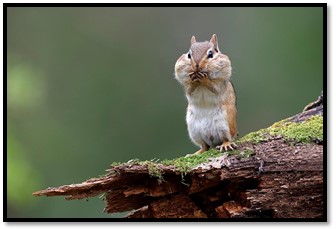Chipmunk

Chipmunk
Tamias
-
Wisconsin is home to two species of chipmunks - the eastern chipmunk and the least chipmunk. Both species of chipmunks weigh roughly 2 to 3 ounces and are 8 to 10 inches in length.
-
Chipmunks are the smallest member of the Sciuridae family, which includes squirrels, prairie dogs, and other rodents.
-
A chipmunk’s cheeks can stretch to be three times larger than their head and are used to carry food to their home for winter storage.
Population: The eastern chipmunk can be found throughout Wisconsin, while the least chipmunk is generally found in the northern half of the state.
Habits: Chipmunks are solitary animals apart from the mating season. They are active during the day and most commonly during the early morning and late afternoon. Chipmunks generally live in mature woodlands, but also inhabit areas around suburban and rural homes. Chipmunks are burrowers and create tunnel systems that range from 10 to 30 feet in length. These tunnels include areas for nesting, food storage, and even escape routes that branch off from the main tunnel.
Chipmunks enter a partial hibernation during late Fall/Winter and do not sleep all the way through the season. They will stay in their burrows but will wake up every few days to feed on stored food rather than use their fat reserves. Generally, chipmunks will then fully emerge in late March.
Diet: Chipmunks, like squirrels, are omnivores and are not picky eaters. A chipmunk’s diet usually consists of nuts, seeds, berries, mushrooms, and insects. They are also known to prey on small birds and their eggs. Chipmunks are known for storing food in their cheeks to bring to their home and store for winter. A single food compartment in a chipmunk’s tunnel can hold around 9 gallons of food.
Mating and Young: Chipmunks usually mate only once a year during early spring and typically have a litter of up to seven kits in May or June. Within eight weeks, the kits are considered fully grown and will emerge from the nest on their own.
Information from: http://wildlifedamage.uwex.edu/pdf/Chipmunk-GroundSquirrel.pdf and https://www.eekwi.org/animals/mammals/chipmunk
To download this information: Click Here
